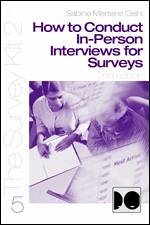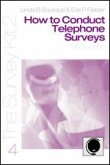'The discussion of qualitative interviewing is a good addition, and the discussion of translating survey questions is very good.'''Juanita M. Firestone, University of Texas, San Antonio'''''The security of data and the transitions sections are very useful for students.'''Dan Johnson, University of North Carolina, Wilmington''''''When should you use an in-person interview for a survey? How do you train the interviewers as well as the programmers for computer-assisted interviews (CAPI)? How do you deal with refusals to be interviewed? Aimed at answering these questions and more, this carefully written, friendly book will help you prepare and administer effective in-person survey interviews. Beginning with the administrative considerations involved in setting up in-person interviews, Oishi explains how to: write interview questions from a flowing interview script with appropriated placed transition statements through to the preparation of useful visual aids; design an eligibility screen; write preletters and scripts for a precall; develop job descriptions for interviewers as well as design interviewer training sessions; record and correct response errors in paper and CAPI interviews; and, clean the data. Completely revised, the book also includes coverage of: ''+ Cultural considerations for in-person interviews''+ Translation of interviews into other languages''+ Differences in quantitative and qualitative interview styles''+ How to train CAPI interviews as well as the program instructions''+ Expanded coverage of the role of the supervisor, including a sample of a full training manual''+ Methods for creating an appropriate environment for in-person interviews, including how to dress and talk to people''+ Updated coverage of informed consent, including a sample of a consent form'''''''The text is very readable and conveys a tremendous amount of information. There is good use of checklists that are clear, easy to read and appropriate as well as good examples. The references to the literature provide good resources for those who need more.'''Carol J. Lancaster, Medical University of South Carolina''''
Hinweis: Dieser Artikel kann nur an eine deutsche Lieferadresse ausgeliefert werden.
Hinweis: Dieser Artikel kann nur an eine deutsche Lieferadresse ausgeliefert werden.








